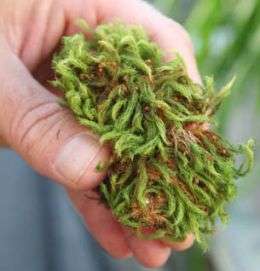Haller’s apple moss only grows in areas with high precipitation and low elevation.
René Belland has a soft spot for moss - especially Haller's apple moss. "It's so soft. If you found a field full of it, you'd just want to lie down in it," said the assistant director of research at the University of Alberta's Devonian Botanic Garden.
A field full of the moss is not likely to turn up, as it's a rare, endangered species. Belland, however, has discovered the largest population of Haller's apple moss ever in Alberta and in North America.
Belland discovered the moss this summer in the western side of Jasper National Park. The moss is listed as threatened under the federal government's Species At Risk Act. There are two other known locations for this moss in the national park, and other sites with numerous colonies in British Columbia, but this is the largest find by far.
The moss is so-named for its tiny, apple-shaped spore capsules which grow on a stalk that is only two millimetres long. "It's quite a beautiful and distinctive moss, and but not easy to find," said Belland. "It has a very specific habitat. It only grows in areas that are really, really wet, in terms of precipitation and in low elevations."
It also grows in parts of Britain, Scandinavia and east Asia, but was first discovered in Canada in 1825 by Thomas Drummond, a naturalist who travelled along the Hudson's Bay trade route where he discovered the species on the Wood River in British Columbia. In North America, Haller's apple moss only grows in the western slopes of the Rocky Mountains in B.C. and Alberta, hugging the Continental Divide. The next Canadian sighting wasn't until 1960 in Mount Robson Park, and then another small site was found in the 1980s by U of A researcher Dale Vitt. Belland and a colleague found more in B.C. a few years ago, as part of a targeted search program.
"It forms part of our natural heritage, the biodiversity of Canada," said Belland. "Even though it's just one species, we have to preserve that one species. If we don't' care about this one, and we don't care about the next one, eventually Canada will be a country with very, very few species."
The Jasper discovery is a rich find, Belland said.
"Generally, one of the problems with rare species is that there's not a lot of it to work with to figure out what its biology is. This population is big enough that we can actually say that there's lots of it here, and figure out why it's here," he said. "We may be able to determine the environmental parameters important to its survival, and then apply that knowledge to predicting the occurrence of colonies at new locations."
The Jasper park colonies are also the only ones on federally protected land; most of the B.C. colonies are either on private or Crown land and are therefore potentially at greater risk, Belland added.
These findings will help play an important role building a federal recovery plan for this fragile species.
Source: University of Alberta
























